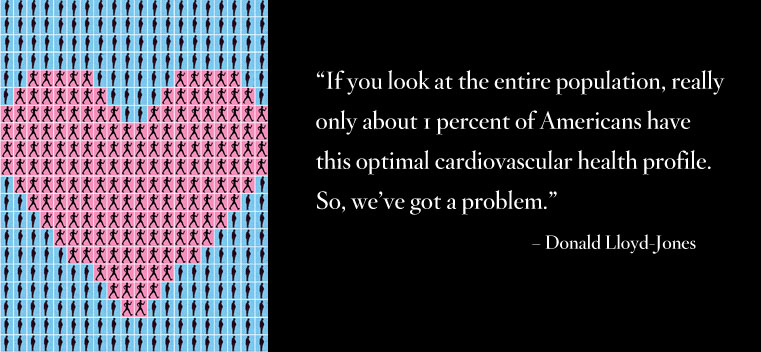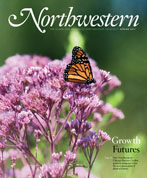
Heart Health
Cardiovascular disease runs in the family for Dop Troutman. His father’s parents both died of heart attacks before age 50 — his grandmother at just 34.
Troutman, at 39, suffered a series of heart attacks while on vacation in 2005. Four of his arteries were almost completely blocked.
Six weeks after undergoing quadruple bypass surgery he moved to Chicago, but the job he was moving for had been filled during his recovery. Troutman struggled with the transition. He avoided the gym and ate fast food.
Then he met Donald Lloyd-Jones, chair of preventive medicine at the Feinberg School of Medicine. Out of all the cardiologists Troutman had seen, Lloyd-Jones “was the first person who didn’t feel sorry for me. He was the only one who said, ‘You can control this.’ ”
Troutman took the challenge. He started Nutrisystem and lost 20 pounds in a month. Otherwise healthy and fit before his heart troubles, Troutman went back to the gym and shed another 20 pounds with cardio, and his blood pressure and cholesterol plummeted.
A year later he has kept the weight off, thanks in large part to Lloyd-Jones. “I hear him in my head,” Troutman says. “When I want to eat a cheeseburger, when I don’t want to go to the gym, I hear his voice in my head: ‘You can do this.’
“I don’t feel like I’m a slave to my heart disease anymore,” he adds.
Troutman’s story, while extreme, is also all too common. At present, fewer than 5 percent of Americans make it to middle age (ages 45 to 65) with an optimal cardiovascular health profile — low cholesterol, low blood pressure, no smoking, no diabetes, regular physical activity, a healthy diet and not overweight. “And if you look at the entire population,” Lloyd-Jones adds, “really only about 1 percent of Americans have this optimal profile. So, we’ve got a problem.”
Lloyd-Jones received the 2010 Chairman’s Award, the highest honor for volunteer services awarded by the American Heart Association, for his leadership of the committee that defined this optimal profile for cardiovascular health. He says the seven factors are clearly associated with longer life, longer life lived free of cardiovascular as well as other chronic diseases of aging, better quality of life and reduced need for medical resources and medical health care costs.
“It’s a pretty powerful package,” he says. “And if you make it to middle age with this optimal profile of cardiovascular health, it’s essentially like the fountain of youth for your heart and really your whole body.”
Defining the ideal profile was likely the easy part. Getting more people to achieve this profile falls on all of us.
“We really need to focus our efforts on changing the public health environment,” Lloyd-Jones says, “so it’s possible for people to make healthy lifestyle choices, where they have access to healthy diets, whole foods, affordable produce. In the Chicago community there is square mile after square mile of food deserts where there is no produce available, period. How can you make a healthy choice if you can’t even get to a store that has it?”
Lloyd-Jones adds more to the list — safe, walkable communities; a focus on school-age education and application of healthy diets and physical activity; widespread indoor smoking bans; legislative and policy priorities that move farm subsidies away from soy and corn and toward healthy, whole grains; and taxes on high-sodium or high-sugar foods “because those costs already come out of all of the rest of our paychecks to pay for the downstream health consequences.
“We need to have, I think, mature conversations about these things, not hysterical conversations,” Lloyd-Jones says. “Should we legislate what people eat at every meal, absolutely not, and I bristle when I hear people say that that’s what we’re doing. But we can certainly tilt the playing field so people at least have the option to make healthier choices.”
He advises filling up on fruits, vegetables and whole grains and dropping unnecessary calories from sugar-sweetened beverages, high-fat foods, high-fat dairy and animal proteins. Cut the sodium intake in your diet, he says, by limiting high-salt packaged foods.
“If there’s one thing I could change about the population, it would be to reduce caloric intake,” he says. And, of course, get active. “If you’re doing nothing, do something, and if you’re doing something, do more.”



 Facebook
Facebook Twitter
Twitter Email
Email


